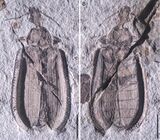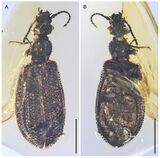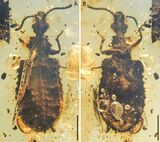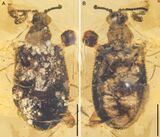Biology:Ommatidae
| Ommatidae | |
|---|---|
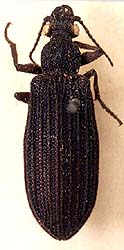
| |
| Omma stanleyi | |
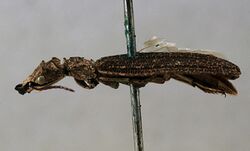
| |
| Tetraphalerus wagneri | |
| Scientific classification | |
| Domain: | Eukaryota |
| Kingdom: | Animalia |
| Phylum: | Arthropoda |
| Class: | Insecta |
| Order: | Coleoptera |
| Suborder: | Archostemata |
| Family: | Ommatidae Sharp & Muir, 1912 |
The Ommatidae are a family of beetles in the suborder Archostemata.[1] The Ommatidae are considered the extant beetle family that has most ancestral characteristics.[2] There are only seven extant species, confined to Australia and South America. However, the geographical distribution was much wider during the Mesozoic spanning across Eurasia and Australia, suggesting that they were widespread on Pangea.[3] So far, over 26 extinct genera containing over 170 species of these beetles have been described.[4] Three extant genera have been assigned to this family: Omma, Tetraphalerus and Beutelius.[5] The family is considered to be a subfamily of Cupedidae by some authors,[6] but have been found to be more closely related to Micromalthidae in molecular phylogenies.[7] A close relationship with Micromalthidae is supported by several morphological characters, including those of the mandibles and male genitalia.[8] Due to their rarity, their ecology is obscure, it is likely that their larvae feed on deadwood.[9]
Genera
According to Kirejtshuk, 2020[6] and subsequent literature.
Extinct genera
- †Allophalerus Kirejtshuk 2020 Early Jurassic-Late Cretaceous (Asia)
- †Asiania Lee et al. 2023[10] Early Cretaceous (South Korea)
- †Blapsium Westwood, 1854 Middle Jurassic (England)
- †Brochocoleus Hong, 1982 Early Jurassic-Late Cretaceous (Eurasia)
- †Bukhkalius Kirejtshuk and Jarzembowski 2020 Burmese amber, Myanmar, mid-Cretaceous (Albian-Cenomanian)
- †Burmocoleus Kirejtshuk 2020 Burmese amber, Myanmar, mid-Cretaceous (Albian-Cenomanian)
- †Cionocoleus Ren, 1995 Middle Jurassic-Early Cretaceous (Eurasia)
- †Cionocups Kirejtshuk 2020 Burmese amber, Myanmar, mid-Cretaceous (Albian-Cenomanian)
- †Clessidromma Jarzembowski et al. 2017 Burmese amber, Myanmar, mid-Cretaceous (Albian-Cenomanian)
- †Diluticupes Ren 1995 Middle Jurassic-Early Cretaceous (Eurasia)
- †Echinocups Kirejtshuk and Jarzembowski 2020 Burmese amber, Myanmar, mid-Cretaceous (Albian-Cenomanian) (other authors consider this genus a junior synonym of Notocupes[11])
- †?Eurydictyon Ponomarenko, 1969 Early Jurassic (Kyrgyzstan) (possibly closely related to Notocupes[12])
- †Jarzembowskiops Kirejtshuk 2020 Burmese amber, Myanmar, mid-Cretaceous (Albian-Cenomanian)
- †Kirejtomma Li & Cai, 2021 Burmese amber, Myanmar, mid-Cretaceous (Albian-Cenomanian)
- †Lepidomma Jarzembowski et al. 2019 Burmese amber, Myanmar, mid-Cretaceous (Albian-Cenomanian)
- †Liassocupes Zeuner 1962 Early Jurassic (England)
- †Limnomma Li & Cai in Li et al. 2021, Middle Jurassic (China)
- †Lithocupes Ponomarenko, 1966 Late Triassic (Kyrgyzstan)
- †Miniomma Li, Yamamoto & Cai, 2020, Burmese amber, Myanmar, mid-Cretaceous (Albian-Cenomanian)
- †Monticupes Ren 1995 Middle Jurassic-Early Cretaceous (China)
- †?Notocupes Ponomarenko, 1964 Middle Triassic-Late Cretaceous (Eurasia) (other authors have considered this genus more closely related to Cupedidae[12])
- †?Notocupoides Ponomarenko, 1966 Late Triassic (Kyrgyzstan) (possibly closely related to Notocupes[12])
- †Odontomma Ren et al. 2006 Early Cretaceous (China)
- †Paraodontomma Yamamoto 2017 Burmese amber, Myanmar, mid-Cretaceous (Albian-Cenomanian)
- †Pareuryomma Tan et al. 2012 Early Cretaceous (China)
- †Polyakius Kirejtshuk 2020 Burmese amber, Myanmar, mid-Cretaceous (Albian-Cenomanian)
- †?Rhabdocupes Ponomarenko, 1966 Late Triassic (Kyrgyzstan) (possibly closely related to Notocupes[12])
- †Rhopalomma Ashman et al. 2015 Late Jurassic (Australia)
- †Stegocoleus Jarzembowski and Wang 2016 Burmese amber, Myanmar, mid-Cretaceous (Albian-Cenomanian)
- †Tetraphalerites Crowson 1962 Eocene (England)
- †Zygadenia Handlirsch, 1906 Early Jurassic-Early Cretaceous (Eurasia, ?Australia) (probably closely related to Notocupes[12])
Extant genera
- Omma Newman, 1839 Late Triassic-Late Cretaceous (Eurasia), recent (Australia)
- Tetraphalerus Waterhouse, 1901 Middle Jurassic-Early Cretaceous (Asia) recent (South America)
- Beutelius Escalona et al., 2020 Recent, (Australia)
The extinct genus Fuscicupes Hong and Wang 1990 was included in the family by some authors, but was excluded by Kirejtshuk (2020).
Gallery
References
- ↑ "Australian Faunal Directory". Department of the Environment and Energy. http://www.environment.gov.au/biodiversity/abrs/online-resources/fauna/afd/taxa/Archostemata.
- ↑ Hünefeld, Frank; Marvaldi, Adriana E.; Müller, Bianca; Lawrence, John F.; Beutel, Rolf Georg (2011). "The male postabdomen of the "ancestral" archostematan beetle Tetraphalerus bruchi Heller, 1913 (Ommatidae) and its phylogenetic significance". Arthropod Structure & Development 40 (2): 146–158. doi:10.1016/j.asd.2010.12.003. PMID 21185393. Bibcode: 2011ArtSD..40..146H.
- ↑ Yamamoto, Shûhei (2017). "A new genus of Brochocoleini beetle in Upper Cretaceous Burmese amber (Coleoptera: Archostemata: Ommatidae)". Cretaceous Research 76: 34–39. doi:10.1016/j.cretres.2017.04.008. Bibcode: 2017CrRes..76...34Y.
- ↑ Song, Zhenyu; Zhao, Xianye; Jarzembowski, Edmund A.; Xiao, Chuantao (2022-09-01). "Overview of and taphonomic bias in Archostemata (Insecta: Coleoptera) from Cretaceous amber" (in en). Palaeontographica Abteilung A 323 (4–6): 119–137. doi:10.1127/pala/2022/0131. ISSN 0375-0442. Bibcode: 2022PalAA.323..119S. http://www.schweizerbart.de/papers/pala/detail/323/101772/Overview_of_and_taphonomic_bias_in_Archostemata_In?af=crossref.
- ↑ "Ommatidae Species List". Joel Hallan’s Biology Catalog. Texas A&M University. http://insects.tamu.edu/research/collection/hallan/Arthropoda/Insects/Coleoptera/Family/Ommatidae.txt.
- ↑ 6.0 6.1 Kirejtshuk, Alexander G. (2020-02-17). "Taxonomic Review of Fossil Coleopterous Families (Insecta, Coleoptera). Suborder Archostemata: Superfamilies Coleopseoidea and Cupedoidea". Geosciences 10 (2): 73. doi:10.3390/geosciences10020073. ISSN 2076-3263. Bibcode: 2020Geosc..10...73K.
- ↑ McKenna, Duane D.; Shin, Seunggwan; Ahrens, Dirk; Balke, Michael; Beza-Beza, Cristian; Clarke, Dave J.; Donath, Alexander; Escalona, Hermes E. et al. (2019-12-03). "The evolution and genomic basis of beetle diversity" (in en). Proceedings of the National Academy of Sciences 116 (49): 24729–24737. doi:10.1073/pnas.1909655116. ISSN 0027-8424. PMID 31740605. Bibcode: 2019PNAS..11624729M.
- ↑ Hörnschemeyer, Thomas (July 2009). "The species-level phylogeny of archostematan beetles-where do Micromalthus debilis and Crowsoniella relicta belong?" (in en). Systematic Entomology 34 (3): 533–558. doi:10.1111/j.1365-3113.2009.00476.x. Bibcode: 2009SysEn..34..533H. https://onlinelibrary.wiley.com/doi/10.1111/j.1365-3113.2009.00476.x.
- ↑ Adam., Slipinski (2020). "2:Ommatidae". Australian Beetles Volume 2 : Archostemata, Myxophaga, Adephaga, Polyphaga (part).. CSIRO Publishing. ISBN 978-0-643-09731-5. OCLC 1127945248. http://worldcat.org/oclc/1127945248.
- ↑ Lee, Soo Bin; Nam, Gi Soo; Park, Jong Kyun; Lee, Byong Ho; Li, Yan-Da (2023-10-30). "Cretaceous beetles of the Jinju Formation (Coleoptera): Archostemata". Palaeoentomology 6 (5). doi:10.11646/palaeoentomology.6.5.8. ISSN 2624-2834. https://www.mapress.com/pe/article/view/palaeoentomology.6.5.8.
- ↑ Li, Y.-D.; Tihelka, E.; Newton, A. F.; Huang, D.-Y.; Cai, C.-Y. (2023). "New species of Notocupes (Coleoptera: Archostemata) from the Middle Jurassic Daohugou beds, with discussion on the generic circumscription". Palaeoentomology 6 (4): 398–415. doi:10.11646/palaeoentomology.6.4.11.
- ↑ 12.0 12.1 12.2 12.3 12.4 Li, Yan-Da; Tihelka, Erik; Yamamoto, Shûhei; Newton, Alfred F.; Xia, Fang-Yuan; Liu, Ye; Huang, Di-Ying; Cai, Chen-Yang (2023-08-22). "Mesozoic Notocupes revealed as the sister group of Cupedidae (Coleoptera: Archostemata)". Frontiers in Ecology and Evolution 11. doi:10.3389/fevo.2023.1015627. ISSN 2296-701X.
External links
- Ommatidae Tree of Life
- "Ommatida". Atlas of Living Australia. https://bie.ala.org.au/species/urn:lsid:biodiversity.org.au:afd.taxon:9669ef5c-0231-4e6a-9f65-d1b8c240b1eb.
Wikidata ☰ Q135044 entry
 |

